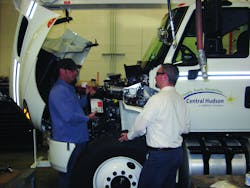In addition to being required by law, pre- and post-trip inspections are essential to the safe and efficient operation of a fleet.
A good pre-trip inspection keeps the driver from leaving your facility with a vehicle that has an existing problem. A good post-trip inspection gives the shop time to react to a problem that has been identified and to correct it before the truck goes back out on the road.
Don't assume that every driver knows what he or she is looking for during a pre- or post-trip inspection or that they even know the proper way to conduct one. And don’t assume the inspections are completed on a regular basis or that the driver understands what is critical in terms of documentation to get the problem fixed.
If you want good, thorough inspections, you need to spend time training (and retraining) drivers on the proper way to perform them. You also need to train your shop to take the results of those inspections seriously and correct problems that are brought to their attention while letting both dispatch and driver know anything that was not taken care of (non-safety related) and request the truck be returned at the earliest possible opportunity.
Walk drivers through the important areas you want them to examine during their inspections. Are they noticing the rust streaking on the lug nuts that might be an indication of a loose lug? Did they tilt the hood and check fluid levels? If the unit is constantly low on coolant and there are no visible leaks, do they realize there is probably a bigger problem?
It is also important to have consistent processes in place throughout the fleet that everyone knows and follows. Are your inspections being done on paper or through ELDs?
Watch your drivers to see how they perform an inspection? Do they systematically walk around the truck when they are performing an inspection or do they seem scattered? Are your inspection forms designed to allow for that systematic review?
One good training tool is to stage issues on trucks and ask the drivers to inspect the vehicle to see if they can find them. This is a good exercise for a safety meeting where you can ask drivers for their feedback.
Here some other things to think about when it comes to pre- and post-trip inspections:
- How does the shop access the pre- and post-trip inspection reports?
- How do they close the loop?
- Is there a set parking area around the shop for defective equipment?
- When the equipment is repaired, how are people notified?
While these may seem like basic things, they all play a role in the safe operation of your fleet.
When it comes to pre- and post-trip inspections, you want to make sure everyone understands the big picture of how all the pieces fit together.
Initial training during onboarding is not enough when it comes to pre- and post-trip inspections. People forget or get complacent.
Periodically observe your drivers as they perform their inspections and, based on what you see, provide them with feedback or schedule an additional training session.
Remember, any problems that are identified during a pre- or post-trip inspection and fixed before the truck goes on the road is one less chance for a CSA violation.
About the Author
Joseph Evangelist
Joseph Evangelist previously served as EVP for Transervice, president of LLT International Inc., and CEO of Lend Lease Trucks Inc. Evangelist is a seasoned transportation executive with domestic and international experience in sales, operations, mergers, and acquisitions.
